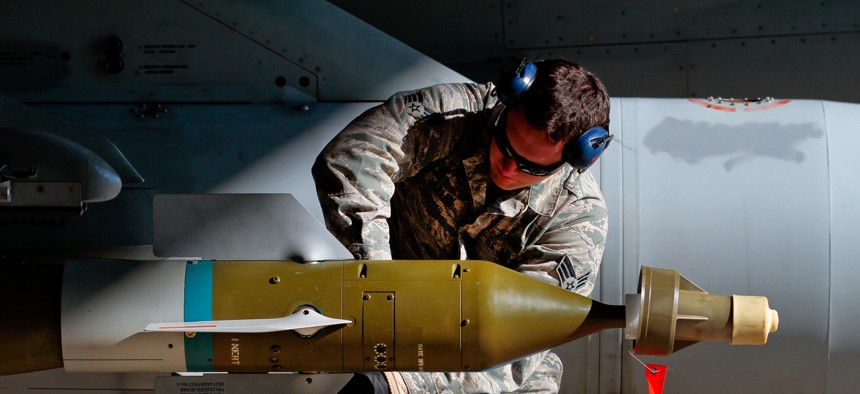
An Airman assembles fins on a GBU-12 Paveway II mounted on an F-16C Fighting Falcon on Jan. 9 at Atlantic City Air National Guard Base, N.J. U.S. Air National Guard photo by Tech. Sgt. Matt Hecht
These Are the New Weapons the Pentagon Chief Wants for Tomorrow's Wars
Defense secretary lays out his vision for the next decade’s killer capabilities in 2017 budget preview.
Smarter smart bombs, mini railguns, and swarming robot boats to watch man-made islands are a few of the key technology areas that Defense Secretary Ashton Carter sees as vital to U.S. military superiority in the next decade. In a preview of the Pentagon’s upcoming 2017 budget request, Carter said military research and development spending would rise to $71.4 billion from last year’s $71.3 billion request.) Carter also listed areas where the Defense Department was already seeing “returns” on R&D spending through the Strategic Capabilities Office, or SCO.
“I’d like to tell you about a few projects SCO has been working on that we’re funding in the budget,” he said. “Some you may have heard of, and some we’re talking about here for the very first time” he said.
Sending Swarmboats to Watch Manmade Islands
Robotic autonomy is critical to the Pentagon’s ambitions to be in more places at less cost. Carter today highlighted “swarming, autonomous vehicles in all sorts of ways, and in multiple domains.
Many military technologists such as Center for a New American Security senior fellow Paul Scharre and New America’s Peter Singer see robotic teaming, or swarming, as a game-changing capability on the battlefield. The military has been researching swarmbots large and small , for years.
Swarming robots aren’t just in the air but also on the water. In 2014, on Virginia’s James River, the Office of Naval Research staged a key demonstration o f the Control Architecture for Robotic Agent Command and Sensing, or CARACaS, system in which 13 self-driving boats conducted highly coordinated maneuvers.
Carter alluded to the demonstration in his Tuesday speech: “And for the water, they’ve developed self-driving boats, which can network together to do all sorts of missions, from fleet defense to close-in surveillance – including around an island, real or artificial, without putting our sailors at risk,” a clear (if indirect) reference to China’s man-made islands in the Pacific.
Smaller Railguns
The high cost of advanced ballistics is driving the military toward cheaper alternatives like direct energy and electromagnetic railgun that hurl shells at hypersonic speeds. The Navy is planning an at-sea demonstration of a BAE designed railgun that can hurl 44-pound shells.
But Carter wants to shrink railgun technology until it can fit into “the five-inch guns at the front of every Navy destroyer, and also the hundreds of Army Paladin self-propelled howitzers. This way, instead of spending more money on more expensive interceptors, we can turn past offense into future defense – defeating incoming missile raids at much lower cost per round, and thereby imposing higher costs on the attacker,” he said.
He noted a January demonstration that equipped a Paladin with railgun capabilities.
Smarter Smart Bombs
Helping bombs find their targets without relying on outside communications (or worse, dumb luck) could decrease errant strikes and save lives. Carter highlighted advanced navigation projects that would use “the same kinds of micro-cameras and sensors that are littered throughout our smartphones today, and putting them on our Small Diameter Bombs to augment their targeting capabilities. This will eventually be a modular kit that will work with many other payloads – enabling off-network targeting through commercial components that are small enough to hold in your hand.”
DARPA’s program in micro-technology for positioning, navigation and timing exemplifies this long-standing,growing research effort.
Arsenal Planes
And where will these smarter smart bombs descend from?
Carter said the Pentagon is working to turn “one of our oldest aircraft platforms” — understood to be the B-52 bomber — into “a flying launch pad for all sorts of different conventional payloads. In practice, the arsenal plane will function as a very large airborne magazine, networked to 5th-generation aircraft that act as forward sensor and targeting nodes – essentially combining different systems already in our inventory to create wholly new capabilities.”
Here’s what that might look like in a real-world mission. Next-generation stealth fighter jets like the F-22 and the F-35 would take the lead in a strike, slipping through and disabling enemy radar and electromagnetic weapons. The arsenal planes would follow to finish the job.
Fifth-generation fighter and older craft have difficulty communicating, which some have highlighted as a critical oversight in planning. Carter today acknowledged that fixing the problem is going to be key to keeping older aircraft relevant.




